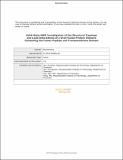| dc.contributor.author | Yao, Hongwei | |
| dc.contributor.author | Lee, Myungwoon | |
| dc.contributor.author | Liao, Shu-Yu | |
| dc.contributor.author | Hong, Mei | |
| dc.date.accessioned | 2018-04-05T13:31:34Z | |
| dc.date.available | 2018-04-05T13:31:34Z | |
| dc.date.issued | 2016-10 | |
| dc.date.submitted | 2016-06 | |
| dc.identifier.issn | 0006-2960 | |
| dc.identifier.issn | 1520-4995 | |
| dc.identifier.uri | http://hdl.handle.net/1721.1/114556 | |
| dc.description.abstract | The fusion peptide (FP) and transmembrane domain (TMD) of viral fusion proteins play important roles during virus–cell membrane fusion, by inducing membrane curvature and transient dehydration. The structure of the water-soluble ectodomain of viral fusion proteins has been extensively studied crystallographically, but the structures of the FP and TMD bound to phospholipid membranes are not well understood. We recently investigated the conformations and lipid interactions of the separate FP and TMD peptides of parainfluenza virus 5 (PIV5) fusion protein F using solid-state nuclear magnetic resonance. These studies provide structural information about the two domains when they are spatially well separated in the fusion process. To investigate how these two domains are structured relative to each other in the postfusion state, when the ectodomain forms a six-helix bundle that is thought to force the FP and TMD together in the membrane, we have now expressed and purified a chimera of the FP and TMD, connected by a Gly-Lys linker, and measured the chemical shifts and interdomain contacts of the protein in several lipid membranes. The FP–TMD chimera exhibits α-helical chemical shifts in all the membranes examined and does not cause strong curvature of lamellar membranes or membranes with negative spontaneous curvature. These properties differ qualitatively from those of the separate peptides, indicating that the FP and TMD interact with each other in the lipid membrane. However, no [superscript 13]C–[superscript 13]C cross peaks are observed in two-dimensional correlation spectra, suggesting that the two helices are not tightly associated. These results suggest that the ectodomain six-helix bundle does not propagate into the membrane to the two hydrophobic termini. However, the loosely associated FP and TMD helices are found to generate significant negative Gaussian curvature to membranes that possess spontaneous positive curvature, consistent with the notion that the FP–TMD assembly may facilitate the transition of the membrane from hemifusion intermediates to the fusion pore. | en_US |
| dc.language.iso | en_US | |
| dc.publisher | American Chemical Society (ACS) | en_US |
| dc.relation.isversionof | http://dx.doi.org/10.1021/acs.biochem.6b00568 | en_US |
| dc.rights | Article is made available in accordance with the publisher's policy and may be subject to US copyright law. Please refer to the publisher's site for terms of use. | en_US |
| dc.source | Prof. Hong via Erja Kajosalo | en_US |
| dc.title | Solid-State Nuclear Magnetic Resonance Investigation of the Structural Topology and Lipid Interactions of a Viral Fusion Protein Chimera Containing the Fusion Peptide and Transmembrane Domain | en_US |
| dc.type | Article | en_US |
| dc.identifier.citation | Yao, Hongwei, et al. “Solid-State Nuclear Magnetic Resonance Investigation of the Structural Topology and Lipid Interactions of a Viral Fusion Protein Chimera Containing the Fusion Peptide and Transmembrane Domain.” Biochemistry, 55, 49 (December 2016): 6787–6800 © 2016 American Chemical Society | en_US |
| dc.contributor.department | Massachusetts Institute of Technology. Department of Chemistry | en_US |
| dc.contributor.approver | Hong, Mei | en_US |
| dc.contributor.mitauthor | Yao, Hongwei | |
| dc.contributor.mitauthor | Lee, Myungwoon | |
| dc.contributor.mitauthor | Liao, Shu-Yu | |
| dc.contributor.mitauthor | Hong, Mei | |
| dc.relation.journal | Biochemistry | en_US |
| dc.eprint.version | Author's final manuscript | en_US |
| dc.type.uri | http://purl.org/eprint/type/JournalArticle | en_US |
| eprint.status | http://purl.org/eprint/status/PeerReviewed | en_US |
| dspace.orderedauthors | Yao, Hongwei; Lee, Myungwoon; Liao, Shu-Yu; Hong, Mei | en_US |
| dspace.embargo.terms | N | en_US |
| dc.identifier.orcid | https://orcid.org/0000-0003-2383-1942 | |
| dc.identifier.orcid | https://orcid.org/0000-0003-3002-6298 | |
| dc.identifier.orcid | https://orcid.org/0000-0002-0022-2637 | |
| dc.identifier.orcid | https://orcid.org/0000-0001-5255-5858 | |
| mit.license | PUBLISHER_POLICY | en_US |
